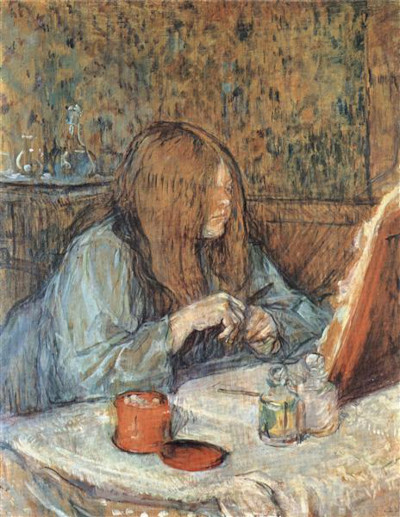This artwork from 1898 was titled Ala Toilette Madame Poupoule, which translates as Madame Poupoule at her Dressing Table. It is the type of scene regularly found within the intimate portraiture of Henri de Toulouse-Lautrec. Today the piece resides as a museum set up in his name.
Madame Poupoule is dressed in nightwear as she stares into a mirror on her dressing table. She leans over, preparing her look for the day. Several bottles and jars can be found on the table, which is covered in a white cloth. The orange pot may have contained rice powder, which was sometimes used for the effect of lightening one's skin, which was considered more beautiful at that time. She has auburn hair which is relatively unstyled, as she starts the day. Behind her is a chest of drawers with glass items on top. The wall is only partially painted by the artist, meaning the original medium shows through in many parts of the composition. It is likely to have been produced on a board, rather than canvas, which explains the dull brown tone which persists in the areas devoid of artistic detail. The style used by this artist is Impressionist-like, where details are added but without precise brushwork, creating an impression of what the artist was witness to at that time.
The painting can be found in the south of France, in the museum specially set up in his name. Many artworks owned by the artist's mother were donated to this institution and it continues to extend his legacy by making new generations aware of Henri's achievements. There are not many artists who have museums dedicated to them alone, and for it to last around a century shows how important this artist was. His connection to several other key names from the art world has also helped others to find his oeuvre, such as the likes of Gauguin and Van Gogh. His concentration on real life in Paris at that time also seems to have helped him to retain his popularity a good century later and he can also be considered successful in an international sense, with some of his paintings now to be found in the US as well.
The artist featured cafe scenes many times, with other notable contributions including the likes of In the Restaurant La Mie, Monsieur Boileau and A Corner of the Moulin de la Galette. He became entirely familiar with those who frequented these establishments the most regularly and was able to produce intimate portraits without any fuss from his subjects. The artist's fragile stature also meant that he would be seen with sympathy by many and encouraged, even before they had seen just how talented he was. It was this positive feedback which made him return again and again, helping to put together a huge survey of the individuals within these venues and helping us to understand their behaviour at that time.




